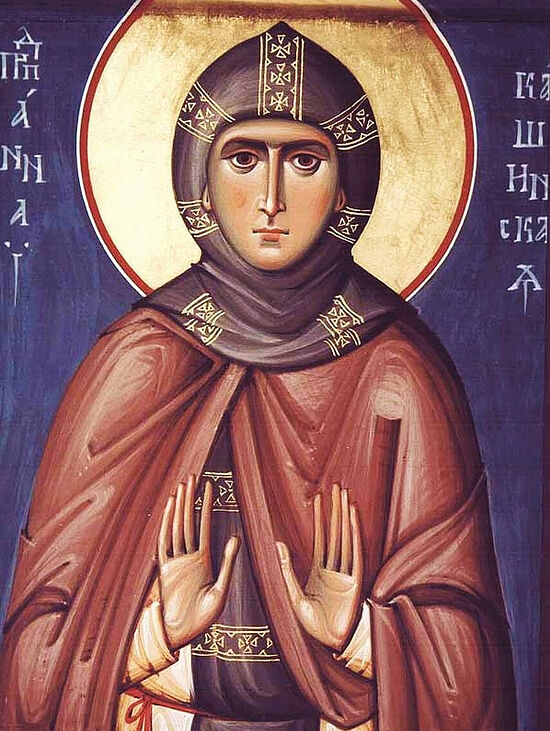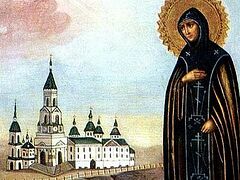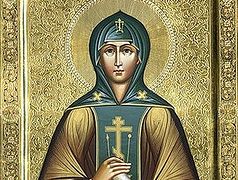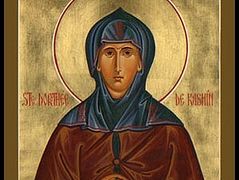A weak woman with a strong character, she went through severe trials in her lifetime and was unjustly forgotten by posterity. Though she became famous for her miracles after her blessed repose, it was not until much later that the holy princess was vouchsafed universal Church veneration. A saint with a complicated destiny in her lifetime and after her death, today she shines to us through the centuries by the light of her holiness.
 The holy Right-Believing Princess Anna of Kashin
The holy Right-Believing Princess Anna of Kashin
From a princely family
Princess Anna’s exact date of birth is unknown, but historians suggest the period 1278—1279. St. Anna was descended from the family of the princes of Rostov. Her father was Prince Dmitry Borisovich of Rostov, and her grandfather was Prince Boris Vasilkovich, “the intercessor for the Russian Land”, who spent most of his life in the Golden Horde. Boris Vasilkovich acted as a goodwill ambassador and an intercessor for his native land before the khans, by the power of his persuasion keeping the cruel representatives of the Horde from raiding, looting, pillaging and killing. Princes of Rostov were noted for their deep faith and good nature. Boris Vasilkovich was friends with St. Peter, the Tsarevich (Crown Prince) of the Horde, who was baptized and moved to Rostov. They even became sworn brothers, and after their deaths their descendants were on good affectionate terms with each other.
Young St. Anna, who came from a noble and very pious family, needed a husband who would be of the same social level and same spirit as her. After her father’s death St. Anna married Prince Michael (Mikhail) of Tver, who later became a holy right-believing prince and a much-venerated saint of the Russian land. They married on the fiancé’s name day, November 1294, on the feast of the Archangel Michael. The Christian marriage of the righteous couple would probably have remained untroubled and peaceful but for a chain of tribulations that had befallen both St. Michael and St. Anna.
Many are the afflictions of the righteous (Ps. 33:20)
The chain of tribulations that befell St. Anna of Kashin can’t be characterized other than by the famous line from Psalm 33. Half a year after their wedding the young couple had to watch the devastating fire that engulfed Tver, and three years later the prince’s palace was burned to the ground. St. Michael only just saved St. Anna from the flames. Fires were raging all over the Principality of Tver, and they were accompanied by drought and loss of cattle. Prince Michael fell seriously ill. And in 1299, little Theodora, the holy couple’s newborn, died in infancy.
However, soon St. Michael recovered and within the ensuing years they had four sons: Dmitry, Alexander, Konstantin and Vasily. As if in reward for the devastation of the lands of Tver by the calamity, St. Michael was blessed by God with the Principality of Vladimir as the only descendant of St. Alexander Nevsky, gaining strength in the political arena. “Of an exceedingly large stature, strong, brave and with an awe-inspiring look”, Michael of Tver was a strong-willed, independent and straightforward person—traits that were dangerous for the Rus’ of that age. The principalities were controlled by the Horde, and conflicts that arose between rulers were not always resolved fairly by negotiations or war. The khans would intervene and act as “arbiters” any moment. The princes’ confrontations were often resolved using dishonest methods. The opponents would resort to dirty tricks, like bribes and false denunciations, removing their rivals from power.
Prince Yury Danilovich of Moscow, who laid claim to the lands of Vladimir, was one of them. Despite persuasion by the clergy, who literally acted as peace-makers during internecine wars, in several years the perfidious ruler won the favor of Khan Uzbek (Öz Beg) in the Horde, returning after one of his visits there with the title “the Prince of Vladimir.” Besides, Yury Danilovich married the khan’s sister, securing strong support of a powerful ally in his claims to the disputed lands.
Realizing that the odds were not in his favor, Prince Michael gave up his Vladimir throne, but his opponent decided to deal a final blow to the noble neighbor. Together with the Tatar troops, Yury Danilovich laid siege to Tver, wishing to do away with St. Michael. The truth, which had been on the Prince of Tver’s side from the very beginning, triumphed again: The adversary was crushed, and his Tatar wife (Konchaka, Khan Uzbek’s sister), along with Yury’s brothers, were taken captive. They were held in Tver as a guarantee of peace; St. Michael treated the captives with honor and after a time gradually released some of them.
The tragedy began with Konchaka’s sudden death, which led to nasty rumors. Trying to convince Uzbek of his own innocence, St. Michael sent his twelve-year-old son Konstantin to the Horde, where he was held hostage as they tried to entice his father to come. In August 1318, St. Anna saw the Prince off to the khan’s headquarters, realizing she wouldn’t see her husband alive again. In the Horde no one was going to listen to St. Michael: he was seized, subjected to cruel torture, and killed.
It is hard for a wife to bury her husband, but it is even harder for parents to commit their children’s bodies to earth. Dmitry, St. Anna’s oldest son, who resembled St. Michael of Tver in courage and straightforwardness, left for the Horde in 1322. The young prince obviously intended to get even with those who had put his father to death. Having agreed with Khan Uzbek on the return of Tver’s control over the Principality of Vladimir, Dmitry ran into the cunning Yury Danilovich in the Horde. After dealing shortly with his father’s killer, the Prince of Tver lost favor with Uzbek, was taken into custody and executed a year later.
Dmitry of Tver was loved by the people and nicknamed “the Fearsome Eyes” for his courage and straightforwardness. Perhaps his death was the final straw for the people of Tver. In August 1327, a petty squabble between a local resident and a representative of the Horde turned into mass carnage and resulted in the annihilation of all the invaders in the lands of Tver. In revenge for that the Tatars returned and started a violent bloodbath that the people of Tver had never seen before. Alexander, another son of St. Anna of Kashin, fled to Lithuania with his family, while it is unknown where the holy princess resided at that time. Later Alexander resolved to come back to his ravaged homeland and try to patch up the quarrel with the Horde. But his visit to the Khan ended in a tragedy: Alexander was executed with his son Theodore.
The angelic habit
The deaths of her husband, sons and grandson had a significant impact on St. Anna and the rest of her life. By tradition women in Rus’ did not remarry, choosing monastic life in their widowhood. Princess Anna, who had gone through many harsh trials, was no exception. Her sister-in-law founded a convent of St. Athanasius close to the Tver Kremlin. It was there that the saint was tonsured with the name Sophia. The exact date of her tonsure is unknown, but according to her Life in 1358 she already bore her monastic name. The nun devoted herself to prayer and fasting, showing obedience to her fellow-nuns and maintaining contacts only with one person from the world—her son Konstantin.
But even in monastic life St. Anna couldn’t find lasting peace. The arrival of Vasily, St. Anna’s other son, in Tver was followed by savage reprisals against her husband’s old companions-in-arms, and the Lithuanian Intervention interfered as well. Vasily convinced his mother to flee with him to Kashin [now a picturesque little town on the banks of the Kashinka River in the Tver region, some ninety-five miles from Tver and about 110 miles north of Moscow.—Trans.], where he built a convent especially for St. Anna. It was in that convent that the holy princess and nun peacefully fell asleep in the Lord on October 2, 1368, reaching a very advanced age. Resigned to the Creator’s will, meek and humble, a woman who firmly endured terrible ordeals, a faithful wife and a loving mother, the princess bore her heavy lot compliantly. According to tradition, on her deathbed St. Anna exhorted her son Vasily and his boyars [members of the old aristocracy in Russia, next in rank to a prince.—Trans.] to live out their faith and be merciful to others.
Sorrows after death
Though St. Anna of Kashin was canonized as one of the “right-believing” saints, seeing her life and the events around her after her repose we want to reward the holy princess with the martyr’s crown. After surviving ordeals in her lifetime, losing her spouse and children, living in life-threatening dangers from natural calamities and enemies of Tver alike, St. Anna continued to be subjected to attacks even after her death.
There was the Dormition Church in Kashin, where according to tradition the holy princess and nun was interred. By the seventeenth century the memory of the righteous princess had sunk into oblivion. Even her coffin that had broken through the church floor did not evoke pious feelings in Kashin residents. Nowadays it is hard to imagine that a tomb in church can be used as a bench or a hat rest during services. One day in 1611, St. Anna appeared to a sick ponomar [until the nineteenth century in Russia ponomars combined the functions of sacristans, acolytes and bell-ringers.—Trans.] named Gerasim in the Dormition Church. The saint scolded him for irreverence toward her relics and commanded him to relate her words to the clergy. As proof of her miraculous apparition, St. Anna healed Gerasim from his serious illness. That event was a starting point for St. Anna’s renewed universal veneration. But that didn’t last.
On July 21, 1649, after the Liturgy at the Dormition Church St. Anna’s tomb was opened in the presence of Archbishop Jonas of Tver, Archimandrite Silvester, and Igumen John. The princess’ body and garments were incorrupt, with her right hand positioned to make the sign of the cross with two (rather than three) fingers as a blessing. Soon the Council of Bishops decreed that the princess’ relics be uncovered for veneration (because since 1611 forty-one miracles of healing at her shrine had been recorded). Then icons of St. Anna were painted and liturgical texts in her honor were composed. A year later, Tsar Alexei Mikhailovich himself arrived to attend the ceremony of the translation of her relics from the Dormition Church to the Resurrection Cathedral in Kashin. Everything would have been fine, but… competent readers know what period of Russian history St. Anna’s canonization coincided with. In the mid-seventeenth century, Russian Church unity was shattered by the schism caused by the reform of the old rites, rule and books. Thus St. Anna became the center of attention as a supposed silent apologist for the “zealots of the ancient piety.” The reform knew no compromises, and a war was declared on all attempts to disagree with the changes in Church life. Under Patriarch Joachim (Savyolov; 1674—1690), St. Anna was officially decanonized by a special commission. The commission found nine discrepancies in her biography, declared the princess’ Life and accounts of miracles unauthentic, and her shrine with relics was sealed up; though it remained at the Resurrection Cathedral because representatives of princely and royal families were generally buried in churches this way.
The triumph of Orthodoxy
Despite the decanonization—that is, the prohibition of her veneration—the faithful did not forget the good princess. People continued to come to St. Anna’s tomb before their weddings, monastic tonsures, the beginning of the school year, and especially with illnesses and sorrows. In 1728, the Burgomaster of Kashin appealed to Vladyka Theophylact of Tver with a request to hold a cross procession on All Saints’ Day from the right-believing princess’ relics to all the town churches. From that day on such cross processions were held annually, with their distinctive feature being carrying the saint’s life-size icon.
In 1786, Bishop Joasaph of Tver, the author of the Life of St. Michael of Tver, became interested in St. Michael’s wife’s biography. After making some inquiries the hierarch charged the dean with the duty of celebrating annual services of intercession to the Theotokos with a reading of the canon to St. Anna of Kashin at her shrine. 100 years later, the holy princess appeared in a vision to Abbess Antonia (Mezentseva), mother-superior of the Convent of the Meeting in Kashin (now inactive), which gave rise to a new wave of veneration for her. And between 1899 and 1909, thirty more cases of miraculous healing at the saint’s shrine were recorded. Perhaps there were more miracles. The tendency of Russian people at that time to pass over in silence miracles they experienced was mentioned by Priest John Amenitsky, dean of the Resurrection Cathedral in Kashin. Meanwhile, miracles were really worth mentioning. All the miracle stories agreed on the following detail: a stately tall nun aged about fifty would appear to supplicants after their prayers in a faint dream and recommend sick people to go to Kashin, to her relics.
A woman related how her three-year old daughter had been seated on the saint’s tomb (this time with a noble purpose) and healed from paralysis. The process of recovery took a week, but not a trace of the illness remained after that. St. Anna appeared to one widow, surrounded by angels. The woman had been unable to move her legs, but after the right-believing princess’ miraculous apparition she was cured and recovered completely. Remarkably, in some cases miracles through St. Anna’s intercessions occurred to the same people more than once. For example, the wife of the merchant Sysoev from Kashin had bad headaches after her wedding. After a vision of the right-believing princess, the woman went to the chapel (that housed her relics) on the saint’s advice. After celebrating a service of intercession with a priest at the princess’ tomb, the sick woman was healed. Several years later, a two-year-old child of the same merchant’s spouse fell sick. And help came from St. Anna again: The saint appeared after the mother’s inconsolable sobbing and fervent prayers, healing the baby from a serious disease.
As a result of popular veneration, obvious supernatural events associated with Princess Anna, plus a strong lobby of the clergy (including those of Edinoverie [the Old belivers who are in communion with the canonical Church.—Ed.]), in April 1909 the Russian Orthodox Church published a statement to its faithful about restoring the veneration of the holy Right-Believing Princess Anna of Kashin. And in the early days of June, not only the faithful of the Diocese of Tver but Orthodox Christians from all over Russia began to flock to the festivities. Old Believers of the Bespopovtsy (i.e. “priestless”) and Popovtsy (i.e., “with priests”) denominations joined the Momentous event. Against the background of the unhealed wound of the Russian schism, this very fact was eloquent evidence of the restoration of the veneration of St. Anna of Kashin for the whole of Russian society of the age.




